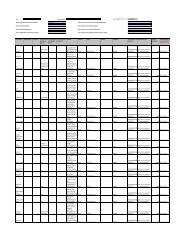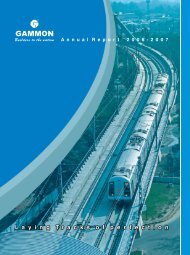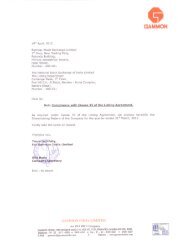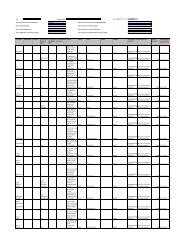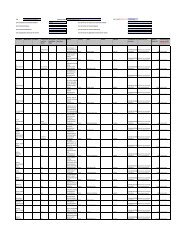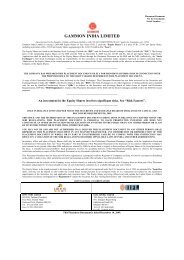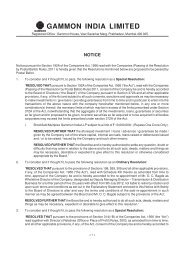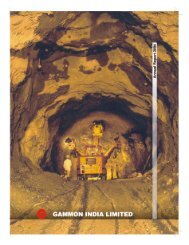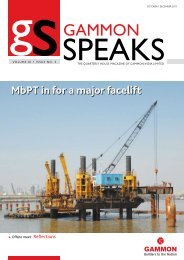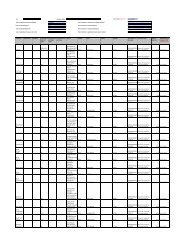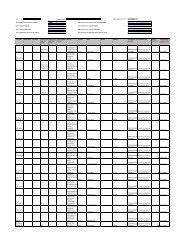Annual Report 2010-2011 - Gammon India
Annual Report 2010-2011 - Gammon India
Annual Report 2010-2011 - Gammon India
You also want an ePaper? Increase the reach of your titles
YUMPU automatically turns print PDFs into web optimized ePapers that Google loves.
SCHEDULE 16<br />
SIGNIFICANT ACCOUNTING POLICIES AND NOTES TO ACCOUNTS<br />
A. SIGNIFICANT ACCOUNTING POLICIES:<br />
80<br />
1. Basis of preparation of Financial Statements:<br />
The financial statements have been prepared to comply in all material respects with the notified accounting standards by the Companies<br />
Accounting Standards Rules, 2006 and the relevant provisions of the Companies Act, 1956. The financial statements have been prepared under<br />
the historical cost convention, on an accrual basis of accounting. The accounting policies discussed more fully below, are consistent with those<br />
used in the previous year.<br />
2. Use of Estimates:<br />
The preparation of financial statements requires estimates and assumptions to be made that affect the reported amount of assets and liabilities<br />
on the date of financial statements and the reported amount of revenues and expenses during the reporting period. Difference between the<br />
actual results and estimates are recognized in the period in which the results are known.<br />
3. Revenue Recognition:<br />
(a) On Construction Contracts:<br />
Long-term contracts including Joint Ventures are progressively evaluated at the end of each accounting period. On contracts under<br />
execution which have reasonably progressed, profit is recognized by evaluation of the percentage of work completed at the end of the<br />
accounting period, whereas, foreseeable losses are fully provided for in the respective accounting period. The percentage of work completed<br />
is determined by the expenditure incurred on the job till each review date to total expected expenditure of the job.<br />
Additional claims (including for escalation), which in the opinion of the Management are recoverable on the contract, are recognized at the<br />
time of evaluating the job.<br />
(b) On supply of materials related to the transmission towers, revenue is recognized upon the delivery of goods to the client in accordance<br />
with the terms of contract. Sales include excise duty & other receivable from the customers but exclude VAT, wherever applicable.<br />
(c) Insurance claims are accounted for on cash basis.<br />
(d) Interest income is recognized on time proportion method basis taking into account the amounts outstanding and the rate applicable.<br />
(e) Dividend Income is accounted when the right to receive the same is established. The dividend declared by the subsidiary companies after<br />
the date of balance sheet are also included if they are in respect of accounting period which closed on or before the date of Company’s<br />
Balance Sheet.<br />
4. Turnover:<br />
Turnover represents work certified upto and after taking into consideration the actual cost incurred and profit evaluated by adopting the<br />
percentage of the work completion method of accounting.<br />
Turnover also includes the revenue from the supply of material in the transmission tower contracts in accordance with the terms of contract.<br />
5. Joint Venture:<br />
(a) Joint Venture Contracts under Consortium are accounted as independent contracts to the extent of work completion.<br />
(b) In Joint Venture Contracts under Profit Sharing Arrangement, services rendered to Joint Ventures are accounted as income on accrual basis,<br />
profit or loss is accounted as and when determined by the Joint Venture and net Investment in Joint Venture is reflected as investments or<br />
loans & advances or current liabilities.<br />
6. Research and Development Expenses:<br />
All expenditure of revenue nature is charged to the Profit and Loss Account of the period. All expenditure of capital nature is capitalized and<br />
depreciation provided thereon, at the rates as applied to other assets of similar nature.<br />
7. Employee Retirement Benefits:<br />
Retirement benefits in the form of provident fund and superannuation is a defined contribution scheme and contributions are charged to the<br />
Profit and Loss Account for the year/period when the contributions are due.<br />
Gratuity a defined benefit obligation is provided on the basis of an actuarial valuation made at the end of each year/period on projected Unit<br />
Credit Method.<br />
Leave encashment is recognized on the basis of an actuarial valuation made at the end of each year on projected Unit Credit Method.<br />
Actuarial gains/losses are immediately taken to profit and loss account and are not deferred.<br />
8. Fixed Assets and Depreciation:<br />
Fixed Assets are valued and stated at cost of acquisition less accumulated depreciation thereon. Revalued assets are stated at the revalued<br />
amount. Cost comprises the purchase price and any attributable cost of bringing the asset to its working condition of its intended use.<br />
Depreciation for the accounting period is provided on:<br />
(a) Straight Line Method, for assets purchased after 2-4-1987, at the rates and in the manner specified in Schedule XIV to the Companies<br />
Act, 1956.<br />
(b) Written Down Value Method, for assets acquired on or prior to 2-4-1987, at the rates as specified in Schedule XIV to the Companies<br />
Act, 1956.<br />
A NNUAL R EPORT I <strong>2010</strong>/11





